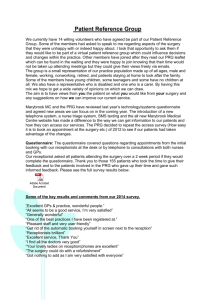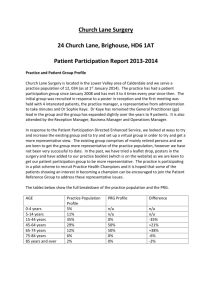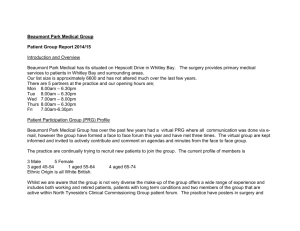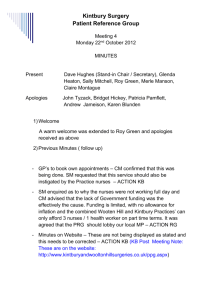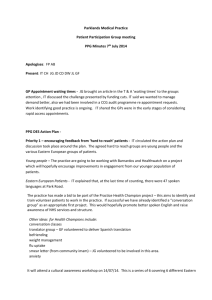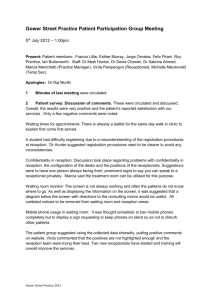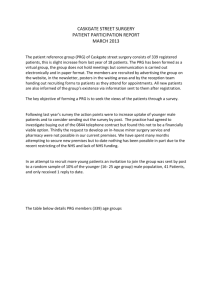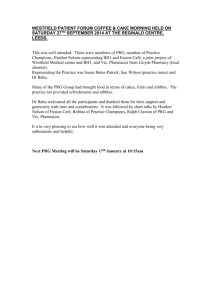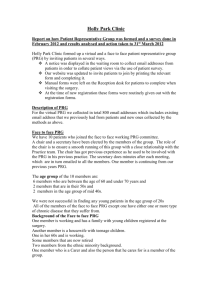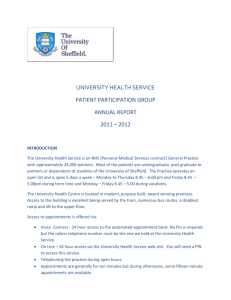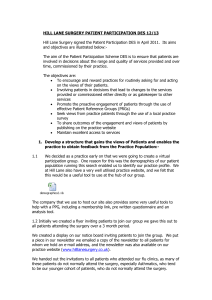Station Drive Surgery, Ludlow
advertisement
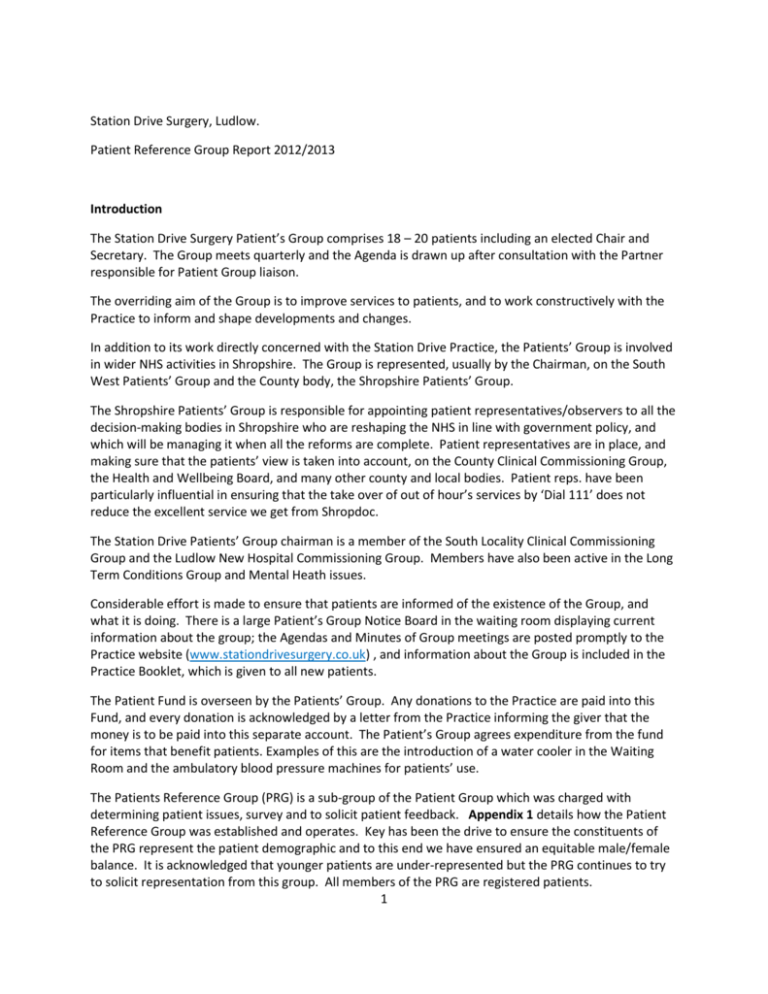
Station Drive Surgery, Ludlow. Patient Reference Group Report 2012/2013 Introduction The Station Drive Surgery Patient’s Group comprises 18 – 20 patients including an elected Chair and Secretary. The Group meets quarterly and the Agenda is drawn up after consultation with the Partner responsible for Patient Group liaison. The overriding aim of the Group is to improve services to patients, and to work constructively with the Practice to inform and shape developments and changes. In addition to its work directly concerned with the Station Drive Practice, the Patients’ Group is involved in wider NHS activities in Shropshire. The Group is represented, usually by the Chairman, on the South West Patients’ Group and the County body, the Shropshire Patients’ Group. The Shropshire Patients’ Group is responsible for appointing patient representatives/observers to all the decision-making bodies in Shropshire who are reshaping the NHS in line with government policy, and which will be managing it when all the reforms are complete. Patient representatives are in place, and making sure that the patients’ view is taken into account, on the County Clinical Commissioning Group, the Health and Wellbeing Board, and many other county and local bodies. Patient reps. have been particularly influential in ensuring that the take over of out of hour’s services by ‘Dial 111’ does not reduce the excellent service we get from Shropdoc. The Station Drive Patients’ Group chairman is a member of the South Locality Clinical Commissioning Group and the Ludlow New Hospital Commissioning Group. Members have also been active in the Long Term Conditions Group and Mental Heath issues. Considerable effort is made to ensure that patients are informed of the existence of the Group, and what it is doing. There is a large Patient’s Group Notice Board in the waiting room displaying current information about the group; the Agendas and Minutes of Group meetings are posted promptly to the Practice website (www.stationdrivesurgery.co.uk) , and information about the Group is included in the Practice Booklet, which is given to all new patients. The Patient Fund is overseen by the Patients’ Group. Any donations to the Practice are paid into this Fund, and every donation is acknowledged by a letter from the Practice informing the giver that the money is to be paid into this separate account. The Patient’s Group agrees expenditure from the fund for items that benefit patients. Examples of this are the introduction of a water cooler in the Waiting Room and the ambulatory blood pressure machines for patients’ use. The Patients Reference Group (PRG) is a sub-group of the Patient Group which was charged with determining patient issues, survey and to solicit patient feedback. Appendix 1 details how the Patient Reference Group was established and operates. Key has been the drive to ensure the constituents of the PRG represent the patient demographic and to this end we have ensured an equitable male/female balance. It is acknowledged that younger patients are under-represented but the PRG continues to try to solicit representation from this group. All members of the PRG are registered patients. 1 Priorities for 2012/13 In the 2011/12 survey four areas were identified as priorities: 1. 2. 3. 4. privacy at the Reception desk Opening times Appointments Telephoning the Practice. The priorities for 2012/13 were discussed at meetings of the Patient Group (as minutes on website). The priorities were seen as soliciting as wide a scope of comment as possible and as such the patient group decided to canvass the opinions of a very large number of patients at the ‘flu day, in order to determine priorities for the survey. This exercise was so successful that the patient group determined that the results could be used directly as a survey output for 2012/13, not least because over 800 patient comments were received. The Patient Group also considers direct feedback and solicited comments from patients via a ‘comments’ posting box in the waiting room, and direct comments received by the Practice as well as consideration from complaints and significant events. 2012/13 Survey The Patient Group chose to conduct the survey by face to face discussion with patients visiting the Practice for a ‘flu vaccination at the Saturday morning special clinic on 20th October 2012. Three members of the group spent 4.5 hours each talking to patients and recording their issues. They estimate that they spoke to 850 out of the over 1,000 patients who attended on that day. Patients spoken to included those who visited the Practice frequently as well as those who rarely visited. Although many were older patients, there was a wide age range which included expectant mothers and young children and patients with disabilities. 75% of patients did not have any issues they wished to raise – the vast majority of these were quite happy with things as they were. 25% of patients wanted to talk about various aspects of the Practice. The PRG reported back to the Patient Group and indeed a direct transcript of all negative comments was made available to the whole Group in order for the full range of comments and discussion to be considered. This was presented at an open meeting and it was determined that the PRG would consolidate the comments into themes and produce a report of the main areas of concern and interest summarising these to the Practice so that an action plan could be evolved. Survey credibility Whilst the survey did not address a randomized group of patients the very large numbers and the direct and open discussions facilitated by the PRG were felt to provide a very credible and representative formative output and survey. 2 PATIENT REFERENCE GROUP SUMMARY There were very many patients who were very happy with the staff and service at the Practice and it was obvious from the many positive comments that patients hold clinicians at the Practice in high regard. It is unfortunate that these numbers were not accurately recorded as I’m sure they would have demonstrated a high percentage of satisfaction. However we were trying to see if there were any areas where patients felt there could be an improvement, which the survey could then focus on. Also if a comment or concern had already been recorded a repeat of that comment/concern may not have been noted. This has been a bit of a learning curve for the volunteers from the Patients’ Group. We will know next time to record all comments. In addition to the high level of satisfaction with the Practice and its staff, the following areas were identified as the main areas of concern to patients: Difficulty in making appointments, especially to see a specific doctor Problems getting an appointment with a GP of patient’s choice at convenient time Turnover of GPs Difficulty in getting through on the phone, especially first thing in the morning Difficulty in using numbered key system when phoning the surgery – find it confusing and would prefer to speak to someone Confidentiality in the surgery, especially for hard of hearing patients or those in wheelchairs – receptionist either has to shout and/or lean forward out of the hatch. Patients at the surgery, especially those waiting to book in, can clearly hear telephone conversations when hatch is open Lack of ‘publicity’ re on-line booking system Special concern re amount of long term use drugs prescribed e.g. insulin, inhalers etc. Usually 1 month prescribed which can be costly for some patients. In addition, the Practice reviewed all of the solicited comments and proposed several other items to be addressed in the action plan. The draft action plan was then circulated to all Patient Group members for their comments. Action Plan Telephone system – problem of getting through especially in the mornings Telephones – difficulty in using the new system Access to named Doctor and ACTION To audit call back wait times To trial dedicated telephone answering responsibilities for Receptionists To consider message (esp in light of 111) To look at reducing telephone demand by adjustment to results protocols Reception team to review message and to arrange meeting with Patient Group representation to modify/amend message. Recruitment of new GP Partner 3 WHEN March/May BY WHOM Reception Immediate March Reception May Reception and Clinical Team May Reception Patient Group Advertising February Partners problem of turnover of GPs Confidentiality at the Reception desk Ventilation in waiting room Advertise volunteer car service Magazines in waiting room online appointment booking for Nurse appointments prescriptions test results system To remind all Receptionists of this issue, and to close the hatch when not dealing with a patient Make one duty Receptionist responsible for checking temperature of waiting room and taking action. Practice to ask Care Co-ordinator to liaise with Patient Group February Practice Administrator February 2013 Receptionists May Patient Care co-ordinator Patient group to review and discuss how this can be improved. Implement this April Patient Group May Reception team Discuss frequency of prescriptions with CCG and then strategic review Process review of this system June/July Partners, March Partners, and Practice admin team rep. 4
